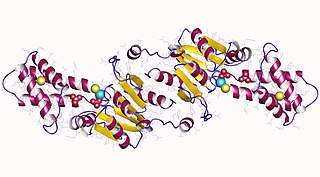External links
| Activity | |
|---|---|
| Regulation | |
| Classification | |
| Kinetics | |
| Types |
|
In biochemistry, an esterase is a class of enzyme that splits esters into an acid and an alcohol in a chemical reaction with water called hydrolysis (and as such, it is a type of hydrolase).
A wide range of different esterases exist that differ in their substrate specificity, their protein structure, and their biological function.

In biochemistry, a phosphatase is an enzyme that uses water to cleave a phosphoric acid monoester into a phosphate ion and an alcohol. Because a phosphatase enzyme catalyzes the hydrolysis of its substrate, it is a subcategory of hydrolases. Phosphatase enzymes are essential to many biological functions, because phosphorylation and dephosphorylation serve diverse roles in cellular regulation and signaling. Whereas phosphatases remove phosphate groups from molecules, kinases catalyze the transfer of phosphate groups to molecules from ATP. Together, kinases and phosphatases direct a form of post-translational modification that is essential to the cell's regulatory network.
In biochemistry, hydrolases constitute a class of enzymes that commonly function as biochemical catalysts that use water to break a chemical bond:
Phosphoric monoester hydrolases are enzymes that catalyse the hydrolysis of O-P bonds by nucleophilic attack of phosphorus by cysteine residues or coordinated metal ions.

Fosfluconazole is a water-soluble phosphate prodrug of fluconazole — a triazole antifungal drug used in the treatment and prevention of superficial and systemic fungal infections.

An exoribonuclease is an exonuclease ribonuclease, which are enzymes that degrade RNA by removing terminal nucleotides from either the 5' end or the 3' end of the RNA molecule. Enzymes that remove nucleotides from the 5' end are called 5'-3' exoribonucleases, and enzymes that remove nucleotides from the 3' end are called 3'-5' exoribonucleases.
The enzyme 2-carboxy-D-arabinitol-1-phosphatase (CA1Pase; EC 3.1.3.63) catalyzes the reaction
The enzyme 2-deoxyglucose-6-phosphatase (EC 3.1.3.68) catalyzes the reaction
The enzyme 3-deoxy-manno-octulosonate-8-phosphatase (EC 3.1.3.45) catalyzes the reaction
The enzyme 5-phytase (EC 3.1.3.72) catalyzes the reaction

In enzymology, a bisphosphoglycerate phosphatase (EC 3.1.3.13) is an enzyme that catalyzes the chemical reaction
The enzyme fructose-2,6-bisphosphate 2-phosphatase ({EC 3.1.3.46) catalyzes the reaction
The enzyme fructose-2,6-bisphosphate 6-phosphatase (EC 3.1.3.54) catalyzes the reaction
The enzyme glucose-1-phosphatase (EC 3.1.3.10) catalyzes the reaction
The enzyme guanidinodeoxy-scyllo-inositol-4-phosphatase (EC 3.1.3.40) catalyzes the reaction
The enzyme inositol-1,4-bisphosphate 1-phosphatase (EC 3.1.3.57) catalyzes the reaction
The enzyme lipid-phosphate phosphatase (EC 3.1.3.76) catalyzes the reaction
The enzyme mannitol-1-phosphatase (EC 3.1.3.22) catalyzes the reaction

The enzyme N-acylneuraminate-9-phosphatase (EC 3.1.3.29) catalyzes the reaction
Asymmetric ester hydrolysis with pig liver esterase is the enantioselective conversion of an ester to a carboxylic acid through the action of the enzyme pig liver esterase. Asymmetric ester hydrolysis involves the selective reaction of one of a pair of either enantiotopic or enantiomorphic ester groups.